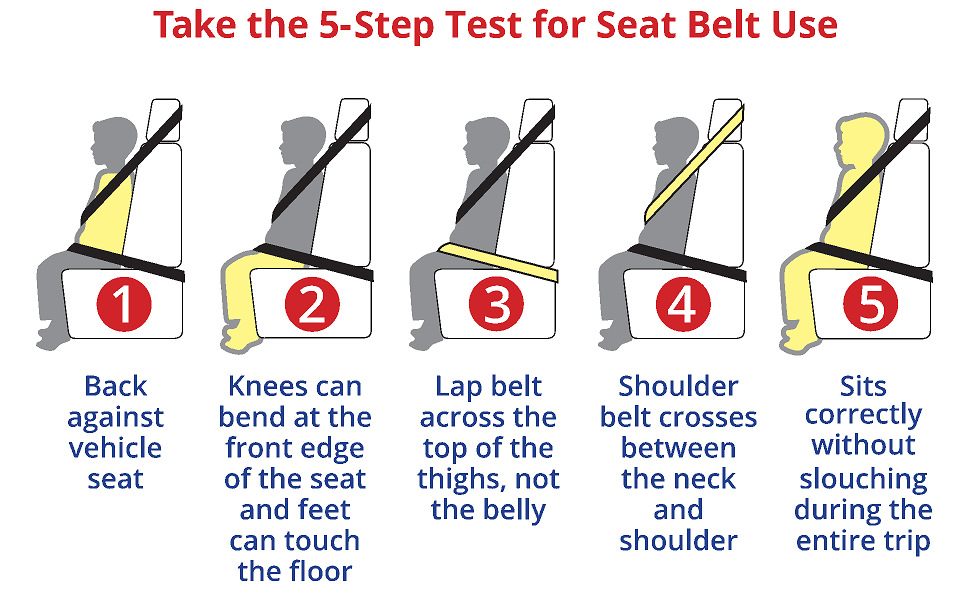Buckling Up is the Best Defense in a Crash!
Car Seats and Seat Belts Prevent Injuries and Safe Lives
Children who are correctly buckled in a car seat, booster seat, or seat belt benefit from the single most effective way to protect motor vehicle occupants and reduce fatalities in a crash. Select the car seat, booster seat, or seat belt that is right for the child’s age, weight, height, and developmental needs. Selecting the correct child restraint type is the first step in making sure a child is safe in the vehicle. Not only will the child ride as safely as possible, a child who is secured during every ride will establish a foundation for a lifelong habit of seat belt use every time the child travels.
5 Ways Car seats and Seat Belts Protect in a Crash
The appropriate selection of an occupant restraint system is determined by the child’s age, weight, height, and developmental needs.
- Preventing ejection from the vehicle:
- People thrown from a vehicle are four times more likely to be killed than those who remain inside. Seat Belts provide the greatest protection against occupant ejection.
- Contacting the strongest parts of the child’s body:
- Seat Belts are designed so that the forces in a crash are absorbed by the strongest areas of your body – the bones of your hips and shoulder.
- Spreading the crash forces across the child’s body:
- A snug lap and shoulder belt spread the force across a large area putting less stress on any one part of the body.
- Providing “ride down” in a crash:
- A quick change in speed is what causes injury.
- Ride down refers to extending the time during a crash that the occupant experiences the slowing down forces.
- The seat belt secures the occupant to the vehicle so the person can take advantage of the extended stopping time/distance provided by the crushing vehicle.
- Protecting the child’s head, neck, and spine:
- A shoulder belt helps to keep the head and upper body away from the hard surfaces inside the vehicle. Seat belts prevent you and other occupants from being thrown into the vehicle, each other, or ejected from the vehicle.
The back seat is the safest location for children under the age of 13 to ride. The back seat eliminates the risk of being injured by the passenger-side front air bag, which is designed to provide additional protection for adults who are properly secured with the seat belt.
- Consider the occupant protection needs of all passengers when installing a car seat.
- Select a seating position that will provide an optimal installation for the car seat.
- The center seat in the back of a vehicle is often referred to as the “safest seating location” because of the protection from side-impact crashes, but any back seat in a vehicle is preferable to a front seat.
- Consider family needs. If parking on a busy street, place the child’s car seat on the curb side for optimal protection when entering and exiting the vehicle.
Teach Children to Buckle Up – Every Time
Consistently Model Seat Belt Use: Wear your seat belt and insist that all family members do the same. Buckling up is not a one-time conversation—it is ongoing. Set the example by always wearing your seat belt and remind children that buckling up is the law. Learning the importance of wearing a seat belt starts with a good role model—and that’s you.
Never Give Up Until They Buckle Up Correctly: Make sure children are buckled up with the lap and shoulder belt. The shoulder belt is never placed behind their back or under their arm. The seat belt is snug and in contact with the child’s body. Motivate children to buckle up properly and reinforce the importance of using a seat belt on every trip. Consistency is key! Remind children to wear a lap and shoulder seat belt every time they get into a car—no matter whose car it is—and to stay buckled up, including at night and on longer rides.

Air Bag Safety
Air bags and seat belts work together to protect older children and adults seated in the front seat of a vehicle. The seat belt keeps the occupant correctly positioned and the air bag adds extra protection for the head and chest and allows the occupant to ride down the crash. It is recommended that all children younger than 13 years of age ride correctly secured in a back seat of the vehicle. If a child must ride in the front seat of the vehicle:
- Secure the child properly and maintain the correct seating position for the entire trip.
- Move the vehicle seat back as far as possible from the dashboard and passenger-side front air bag.
- Refer to the vehicle owner’s manual on the proper way to turn off the passenger-side front air bag, if available.
NEVER place a rear-facing car seat in front of an active passenger side air bag.
